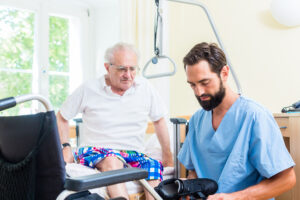What To Do If Your Senior Parent Needs More Help Than You Can Give

In-home care can help seniors with daily care and support when it becomes too difficult for family caregivers.
One of the challenges that family caregivers face is knowing when to get help for a senior parent that is living alone. You can’t do it all, and that’s ok. If you’re struggling to try and balance helping your mom or dad with various tasks, working, and taking care of children or a partner you should know that help is available.
Different types of home care can help your mom or dad with tasks ranging from cleaning the house to changing the linens or even helping them shower or get dressed. One of the areas where family members often struggle to help their mom or dad is helping their senior parent get in and out of bed or get in and out of chairs.
This is called transferring, and if your mom or dad has very little strength or ability to move their body it can be tough to safely move them. In-home care is a type of home care for seniors that can also help safely transfer your mom or dad.
Transferring should always be done by professional in-home care providers to protect your mom or dad and to protect you. In-home care aides who specialize in personal care at home are trained in techniques to safely move seniors of all sizes and abilities. And they also are trained to use assistive equipment that can make transfers easier, like:
Transfer Belt
A transfer belt, also called a gait belt, is a sturdy belt that goes around a senior’s waist to help caregivers lift and support them while moving. It gives the in-home care provider a firm grip, reducing the risk of falls or injuries.
Transfer belts are especially useful when helping a senior stand up, sit down, or move short distances. Some belts come with handles, making it even easier for caregivers to assist safely.
Slide Board
A slide board, or transfer board, is a flat, smooth board that helps seniors move from one surface to another without standing up. The caregiver places one end of the board under the person and the other end on the surface they need to move to, such as a wheelchair or bed.
The senior then slides across the board with the caregiver’s help. This tool is great for those who have some upper body strength but cannot stand or walk.
Sit-to-Stand Lift
A sit-to-stand lift is a motorized or manual device that helps seniors move from a sitting to a standing position. It has a sturdy frame with straps or a harness that supports the person as they are lifted. This tool is useful for seniors who can bear some weight on their legs but need extra help standing. It reduces strain on caregivers and helps prevent falls.
Hoyer Lift
A Hoyer lift, or full-body lift, is a machine that helps caregivers lift and transfer seniors who cannot stand or support their own weight.
It uses a sling to cradle the person while the machine gently lifts them and moves them to another surface. This device is especially useful for bedridden seniors or those with very limited mobility. It prevents injuries for both the caregiver and the senior.
Pivot Disc
A pivot disc is a rotating platform placed under a senior’s feet to help them turn smoothly when moving from one seat to another. It is especially helpful for seniors who can stand but have trouble turning or taking steps.
The in-home care provider helps the person stand on the disc and gently rotates them to face the new seat. This reduces the risk of twisting injuries and makes transfers smoother.
If you or an aging loved one is considering In-Home Care in Alexandria, VA, please contact the caring staff at Thrive Health Care Services today. (703) 992-0484
